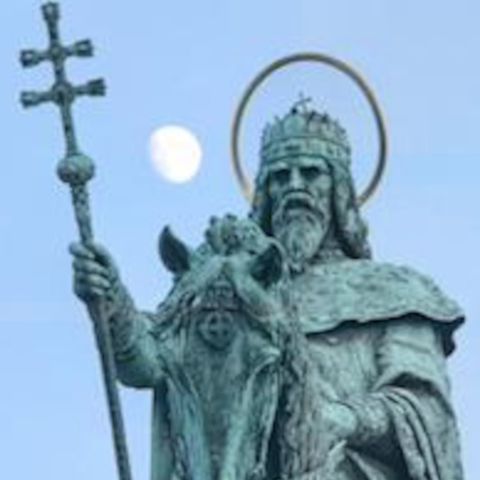August 16: Saint Stephen of Hungary

Scarica e ascolta ovunque
Scarica i tuoi episodi preferiti e goditi l'ascolto, ovunque tu sia! Iscriviti o accedi ora per ascoltare offline.
Descrizione
August 16: Saint Stephen of Hungary c. 975–1038 Optional Memorial; Liturgical Color: White Patron Saint of Hungary and of kings Baptized by his pagan father, made King by the Pope,...
mostra di piùc. 975–1038
Optional Memorial; Liturgical Color: White
Patron Saint of Hungary and of kings
Baptized by his pagan father, made King by the Pope, his heirs demolished his legacy
Saint Stephen of Hungary was a warrior king whose silhouette stands proud on a far distant horizon as the sun rises behind him at the dawn of the medieval age. His year of birth can only be guessed, as ancient chronicles give conflicting dates. His father was of that generation of rough pagans who had to confront the new, vibrant force of Catholicism which challenged the old ways of paganism and its local gods who satisfied local needs. The Mediterranean Basin had long been Christian by the tenth century. But daring missionaries had only recently penetrated deep into the wide plains of the Magyars, the Bulgars, and that vast land of the Rus that lay beyond. That Christian dawn in Eastern Europe is when our saint first comes on the scene.
He was born Vaik and baptized Stephen when his father, a duke, converted to Christianity. When he was about twenty-two, he succeeded his father as a Magyar leader and warlord. After consolidating his territory and power through various wars, he sent an emissary to the Pope in Rome to petition for the founding of Church structures in his land. Pope Sylvester II concurred with Stephen’s plans and took him one step further. Tradition holds that the Pope had a crown fashioned for Stephen and sent it to Hungary, where the papal ambassador crowned Stephen king in 1001.
King Stephen took his duties as a Catholic king with utmost seriousness. He founded an enormous Benedictine monastery, numerous dioceses, and mandated one tax-supported parish with a priest for every ten towns. He built a shrine to the Virgin Mary, which became the sacred forum for the coronations, and burials, of the kings of Hungary. He aggressively punished those who practiced the outlawed pagan customs of yesteryear and prohibited marriages between pagans and Christians. Interestingly, he required that all his subjects be married, except for priests and religious.
After sadly familiar intrigues over succession, money, and power, Stephen died on August 15, 1038. Most of his children had died as infants, and his one adult son, his presumptive heir, died in a hunting accident in 1031. Thus Stephen’s efforts to establish a Christian state were placed in jeopardy. Just as Stephen had feared, once the mighty king died, all of his accomplishments were neglected. Chaos and civil war raged for decades after his burial. The two ostensibly pagan kings who succeeded him were apathetic, or even antagonistic, toward Christianity. The fruits of Stephen’s Christian efforts rotted on the tree, and his immediate legacy dissipated.
Eventually, order was restored to Hungary, and Stephen’s greatness was recognized. He was canonized in 1083. He is now a revered saint-founder of the Hungarian nation. The Huns, the Goths, and the Vandals don’t have a nation today. Over time, these pagan tribes
were absorbed into the stable cultures they invaded. They melted into the many nations and identities of modern Europe. The Magyars, however, did not disappear, merge with other peoples, or melt away. They have their own nation, language, culture, art, and history. They are the people of Hungary, and they owe their enduring identity to Saint Stephen. He imposed the stability of a first-class religion on a horse-riding clan and so transformed that roaming tribe into a stable nation.
Stephen gave his people God. And to God and His Church they were faithful. Hungary matured over the centuries like wine, until it was a refined Christian nation, a defender of Christ and the Church. Neighboring tribes resisted the gospel and dissipated into thin air with the passing of time. Saint Stephen was a model King because he knew that to found a country you have to found a Church along with it.
Saint Stephen, you bear the name of the first martyr of the Church and showed similar courage in battling the enemies of God. May your brave and visionary leadership embolden all civil and church leaders to lay the foundations for a success which flourishes long after they have died.
Informazioni
| Autore | Fr. Michael Black |
| Organizzazione | Michael Black |
| Sito | - |
| Tag |
Copyright 2024 - Spreaker Inc. an iHeartMedia Company

Commenti